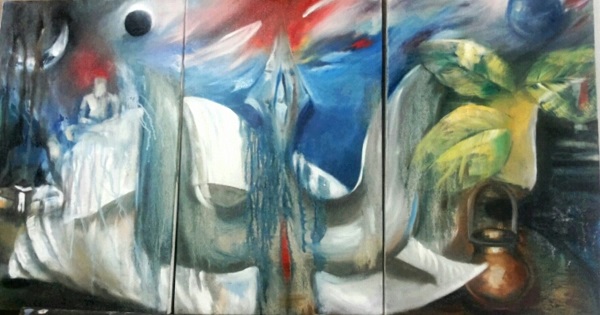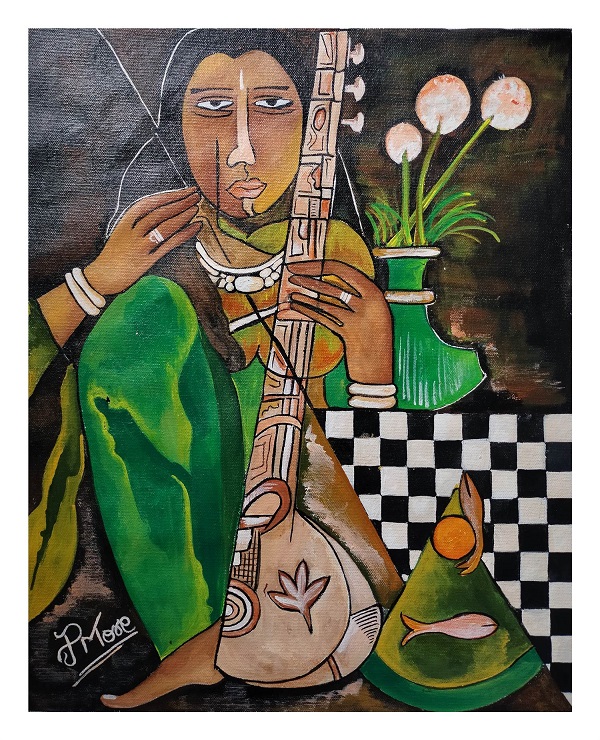
Representing tradition, culture, and India's rich diversity, Indian art has become the top choice. Indian art is also playing a key role by transforming the interior decor with its vibrant colors. Additionally, the way Indian art is presented tells a whole new story to its viewers. This has motivated many people to buy Indian art and revamp their interior decor. Indian art is distinguished by its spiritual and symbolic themes, which are frequently derived from ancient traditions and ideologies. Artworks featuring gods, icons of religion, and mandalas express a deep spiritual significance and calm. In addition, these paintings effectively blend classic subjects with modern viewpoints, providing a timeless appeal that unites the old and the new.
If you think that Indian art is only about traditional and cultural paintings, you might want to take a pause. Indian art is not only just about traditional painting but modern paintings as well. The rich tapestry of India's cultural diversity is the source of the unique charm of modern Indian paintings. They serve as graphic stories that simply express the essence of the country's customs, traditions, and way of life. Indian artists' use of expressive techniques and brilliant colors gives their paintings a dynamic, vivid energy that appeals to a wide range of viewers. This blog aims to explore the many reasons why people need to buy Indian art. Additionally, we will be exploring its unique qualities, cultural depth, and the profoundly transformational power it can have on interior environments.
But before we dive into the topic, it is crucial to understand the true scale of Indian art along with its presence.
-
A study states that a total of 468 artists, or 57 percent of the works sold in FY22-have contributed to the sale of 2,053 pieces.
-
The sale of Indian art generated a whooping USD 75 Million in the first half of 2023.
-
It has been estimated that Indian art will grow at a pace of 12.4% in the next 5 years.
Now that we have observed the stats, let us take a look at the essence of Indian art and its characteristics. This will surely motivate you to buy Indian art represented through modern paintings.
The Essence of Indian Art
Indian art adds a unique flavor to the international art scene. With its unique blend of invention and tradition, modern Indian paintings convey universal messages to a global audience. Furthermore, they convey the spirit of India's rich history and varied customs with the use of vibrant colors and designs. These pieces of art appeal to a broad audience because they serve as a link between the past and the present. Put simply, Modern Indian paintings invite all people to recognize and value the distinct cultural influence they offer to the world of art.

The Fusion of Indian Art with Modern paintings
Indian art combined with contemporary artworks is a fascinating union of tradition and current expression. Indian artists now create a visual language that is timeless by skillfully fusing ancient topics, such as spirituality and symbolism, with fresh viewpoints. Classical topics are given fresh life by this synthesis, which has a timeless and energetic appeal. Furthermore, artists address topics like identity and socioeconomic difficulties via their work as a potent vehicle for social and political criticism. If you buy Indian art, you tend to accept this fusion that improves the aesthetics of your living area. Furthermore, it links you to the changing stories of India's thriving art scene.
The Characteristics of Indian Art
Cultural Diversity and Heritage
The rich cultural legacy and diversity of Indian art are among the strongest arguments in favor of it. India offers artists a wealth of inspiration due to its diverse cultures, dialects, and customs. This is represented in Indian art in its truest form. Thus, people who love Indian themes or vibe usually buy Indian art as per their preference. Furthermore, Indian contemporary paintings frequently feature subjects from mythology, folklore, and everyday life, providing an insight into the dynamic cultural tapestry of the nation.
Vibrant Colors and Expressive Styles
Indian art is recognized for its expressive forms and vivid color scheme. The colorful spirit of the nation is reflected in a spectrum of hues typically found in modern Indian art. These hues improve the overall appearance and feel of the living area in addition to making the artwork more visually attractive. Indian artists have a certain energy that captivates the observer in their abstract paintings, intricate portraiture, and vivid landscapes.
Spiritual and Symbolic Themes
Indian art is deeply spiritual, with modern pieces of art frequently replicating symbolic subjects taken from ancient beliefs. These artworks often feature mandalas, religious symbols, and images of gods, which contribute to their peaceful and spiritually uplifting ambiance. Including Indian art in your home is like extending an invitation for serenity and a closer relationship with high spiritual ideas. The symbolism presented throughout these modern paintings offers a special and effective approach to bringing spiritual harmony and a feeling of cultural richness into your surroundings.
Contemporary Perspectives on Tradition
Indian painters of today showcase an elegant fusion of ancient themes and modern viewpoints, brilliantly reinventing classic topics with a modern flare. Indian art is everlasting because of this harmonic combination that creates a link between the past and modern times. The art form transforms into a dynamic representation of cultural legacy, retaining the essential elements of tradition while adjusting to new tastes. Each work becomes a story that surpasses time limits due to this artistic synthesis, which also connects generations and captivates the audience.

Social and Political Commentary
Many Indian artists of today use their works as an effective forum for social and political views. Through the expressive prism of art, students explore important topics like gender, identity, and socioeconomic difficulties. Purchasing Indian art opens the door to both active interaction with thought-provoking storytelling and the beautiful enrichment of your living area. Every work turns into a visual conversation that invites spectators to consider the complexities of contemporary concerns and strengthens the bond between art and the human condition.
Emerging Talents and Global Recognition
India is home to a flourishing group of young artists that are becoming more and more popular worldwide. If you buy Indian art, you contribute significantly to the development of these artists. Additionally, buying these artworks places you in the context of the larger international conversation on modern art. Indian art is inclusive since it appeals to a diverse spectrum of art fans and represents a wide variety of styles and topics. Engaging with this vibrant art scene enhances your own aesthetic experience while also helping to develop and showcase up-and-coming talent in India's cultural landscape.
Personal Connection and Emotional Impact
Indian art possesses an extraordinary capacity to provoke intense emotional responses. There's no denying that art is a personal experience. Whether it's via the impact of cultural a sense of nostalgia, the wonder produced by representations of the elegance of nature, or the quiet meditation generated by abstract emotions, Indian paintings establish a strong and intimate connection. Indian art engages viewers in a world where personal emotions and creative expressions intersect via the use of customized interpretation. Additionally, Indian art fosters a deep and profound relationship with its rich tapestry.
Unique Craftsmanship and Techniques
Indian art is a colorful patchwork of several traditional methods and creativity. Every painting is an opportunity to showcase the artist's skill in their chosen genre. They can range from powerful strokes of paint of abstract expressions to the delicate elegance of elaborate miniatures. This wide variety of styles gives Indian art a deeper depth while also showcasing the artist's talent. The capacity to switch between styles with ease captures the attention of the audience while highlighting the richness and adaptability inherent in India's cultural legacy.

Read More: Unlocking the Secrets of Selling Modern Paintings Online
Summing Up
Indian art truly represents India’s rich culture, diversity, and tradition in its truest form. Indian art is fascinating because of its remarkable capacity to blend modernity with tradition. Thus, resulting in a visual language that speaks to people all over the world. These paintings' expressive styles, vivid colors, and diversity of cultural influences provide a certain appeal that infuses home design with a hint of symbolism and spirituality. Modern interpretations of tradition guarantee an everlasting appeal by tying the past and present together. Indian art engages spectators in provocative storylines while acting as a potent vehicle for social and political critique.
Investing in Indian art is a voyage of cultural celebration and aesthetic enrichment, supporting up-and-coming artists and recognizing exceptional workmanship. All of these contribute to the dynamic growth of India's artistic environment. So, why wait? Immerse yourself in the captivating world of creativity and buy Indian art to bring a piece of this cultural richness into your living space. Let each stroke and color palette tell a unique story as you embrace the profound beauty of Indian art.
FAQs:
1. How does Indian art differentiate from Western art?
Indian art is different from Western art because it combines spirituality and tradition in a unique way. Indian art is firmly based on cultural symbolism and reflects a spiritual connection. On the other hand, Western art frequently concentrates on individualism and realism. Indian art exhibits a rich cultural past via its different forms, meticulous workmanship, and brilliant colors. Moreover, mythological and folkloric themes are widely explored in Indian art, providing a tale that is closely linked to the nation's past. Indian art stands out due to its different subjects, forms, and cultural settings that enthralls viewers all over the world.
2. What are the different types of Indian Art?
Indian art is diverse and reflects the rich cultural legacy of the nation. Paintings from Madhubani, Tanjore, and Pichwai are examples of traditional art styles, and they come from various geographical areas. A wide range of techniques, such as abstract, cubist, and contemporary expressions, are explored in modern Indian art. Mughal art had a strong effect on miniature paintings, which included fine details. In addition, Kolam art portrays vibrant geometric designs, whilst Warli paintings reflect tribal life. Indian art is diverse and has many facets, as seen in the sculptures, ceramics, and classical dance forms.
3. How does Indian sculpture contribute to art?
Indian sculpture, which depicts the country's cultural and spiritual legacy, is a significant contribution to the rich tapestry of art. Sculptures exhibit exquisite craftsmanship and frequently include historical personalities, mythical stories, and deities. They may be seen in both old temples and modern public areas. Whether made of metal, stone, or another material, the sculptures preserve customs and stories by acting as a visual story. By reuniting individuals with their cultural heritage and offering a physical link to India's rich spiritual past, they enhance the country's visual environment.





















